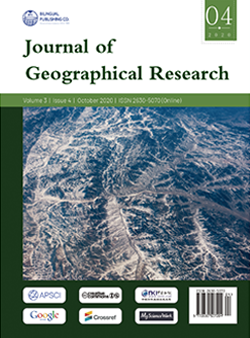-
11567
-
1938
-
1850
-
1712
-
1393
The Size of the Ecumene of the Mediterranean in Ancient Times
DOI:
https://doi.org/10.30564/jgr.v3i4.2030Abstract
For the purpose of this manuscript, we used the old maps of Europe and of the ecumene, as it was known at the time, in order to establish the ecumene properties, as well as the size of the Mediterranean in the time of Ptolemy.We obtained the coordinates (geographic longitude and latitude) from Ptolemy’s map of ecumene of ancient Mediterranean settlements.According to the historical data the coordinates of the Mediterranean ecumene were studied in the 7th century,since the Mediterranean was the centre connecting the civilizations of Europe, Asia and Africa.Although longitudinal and latitudinal errors are large,these coordinates are of great importance for the studies of the past settlements.Today,these settlements are the symbol of civilisation and of human existence.Using the data from 501 settlements overall,we obtained two principal maps of the Mediterranean ecumene with the average density of settlements on the area of 2000 km2.All Ptolemy’s maps, which were used,were of great significance from the scientific point of view, since they made the description of 2000 years old civilization possible.Historically,part of these civilizations,and those formed afterwards,belonged to the Mediterranean.Keywords:
Ptolemy’s ecumene map, Density of settlements, Coordinates, The Mediterranean, Ptolemy, Modern and Ptolemy’s coordinatesReferences
[1] Renou, L. La geographie de Ptolemee. LʼInde Paris, by L. (Foreword), A. Moussa (Foreword),Hans Günter Brauch (Editor), Peter H. Liotta (Editor).Security and Environment in the Mediterranean:Conceptualising Security and Environmental Conflicts, Springer-Verlag Berlin Heidelberg, New York,2003.
[2] Brauch, G. Urbanization and Natural Disasters in The Mediterranean. Population Growth and Climate Change in the 21st Century, (Chapter 11): Building Safer Cities-The Future of Disaster Risk,2003, 149-164.
[3] Pingree, D. The teaching of the Almagest in Late Antique. Apeiron: A Journal of Ancient Philosophy and Science, 1994, 4: 75-98.DOI: https://doi.org/10.1515/APEIRON.1994.27.4.75
[4] Scheglov, D. The error in Longitude in Ptolemys Geography Revisited. The Cartographic Journal,2016,53: 3-14.DOI: https://doi.org/10.1179/1743277414Y.0000000098
[5] Raisz, E.. General cartography, McGrawHill Book Company, NewYork, 1995.
[6] Neugebauer, O. The exact science in Antiguiti. London, 1957.
[7] Morelli, V., Salvati, L. Ad Hoc Urban Sprawl in the Mediterranean city. Dispersing a compact tradition,Roma: Edizioni Nuova Cultura, 2010.
[8] Valjarević, A., Živković, D., Božović, R., Tomanović, D., Krsmanović, S., Cvetković, V.Landscape Changes through History Following the Example of the Former Narrow-Gauge Railroad Belgrade (Čukarica–Obrenovac) Serbia. Journal of Urban History,2019.DOI: https://doi.org/10.1177/0096144219877882
[9] Leontidou, L. The Mediterranean City in Transition.Cambridge: New York: Cambridge University Press,2002.
[10] Russell, C. Late Ancient and Medieval Population.Transactions of the American Philosophical Society,1958, 48:111-152.DOI: htttps://doi.org/10.2307/1005708
[11] Gill, N (n.d.). Main Roman Provinces with Their Dates. 2016. Avaiable from http://ancienthistory.about.com/od/romemaps/f/RomanProvinces
[12] Matvejevic, P. Mediterranean. A Cultural Landscape.(M. H. Heim, Trans.). University of California Press,Mediterranean. (n.d.). In Oxford Dictionaries, USA,1999.
[13] Scheglov, D. Eratosthenes’ Contribution to Ptolemy’s Map of the World. Imago Mundi: The International Journal for the History of Cartography, 2017, 69:159-175.DOI:http://dx.doi.org/10.1080/03085694.2017.1312112
[14] Delanty, G. The Historical Regions of Europe: Civilizational Backgrounds and Multiple Routes to Modernity. Historická Sociologie, 2012, 2: 9-24.
[15] Giordano, C. Mediterranean Region. 2016, 5: 1201-1209.
[16] John, H, Thomas, L. Climate Change during and after the Roman Empire: Reconstructing the Past from Scientific and Historical Evidence. Journal of Interdisciplinary History, 2012, 43:169-220.DOI:http://doi.org/10.1162/JINH_a_00379
[17] McCormick, M., Ulf Büntgen, M. A., Cane, E.,Cook, K. H., Peter J. H., Thomas L, et al. Climate Change during and after the Roman Empire: Reconstructing the Past from Scientific and Historical Evidence. Journal of Interdisciplinary History, 2012,43:169-220.DOI: DOI: https://doi.org/10.1162/JINH_a_00379
[18] Relano, F. Against Ptolemy: The significance of the lopes-Pigafetta map of Africa. Imago Mundi:The International Journal for the History of Cartography,1995, 47(1): 49-66, 1995.DOI: https://doi.org/10.1080/03085699508592813
[19] Kleineberg, A., Marx, C., Lelgeman, D.. Europa in der Geographie des Ptolemaios Die Entschlüsselung des. Atlas Oikumene. Zwischen Orkney, Gibraltar und den Dinariden, Academic in Wissenschaftliche Buchgesellschaft (WBG), 2012.
[20] Strang, Alastair. The analysis of Ptolemeys Geography, The Cartographic Journal, 1998, 35(1):27-47.DOI: https://doi.org/10.1179/000870498787074074
Downloads
How to Cite
Issue
Article Type
License
Copyright © 2020 Aleksandar Djordje Valjarević

This is an open access article under the Creative Commons Attribution-NonCommercial 4.0 International (CC BY-NC 4.0) License.




 Aleksandar Valjarević
Aleksandar Valjarević





